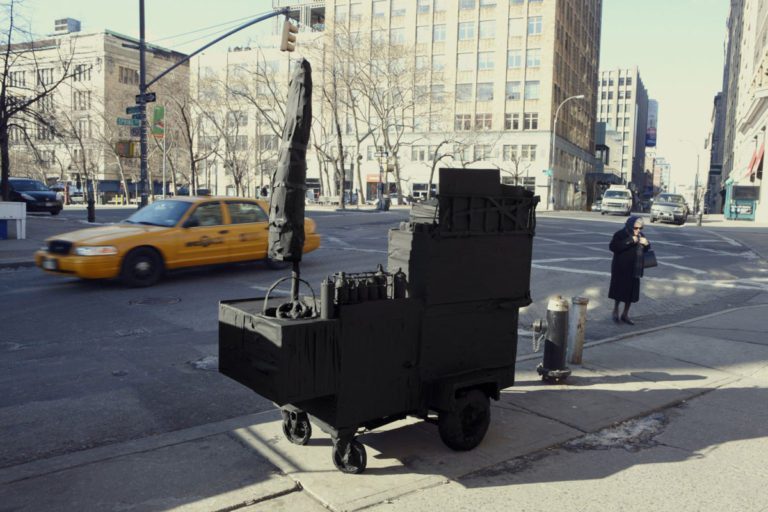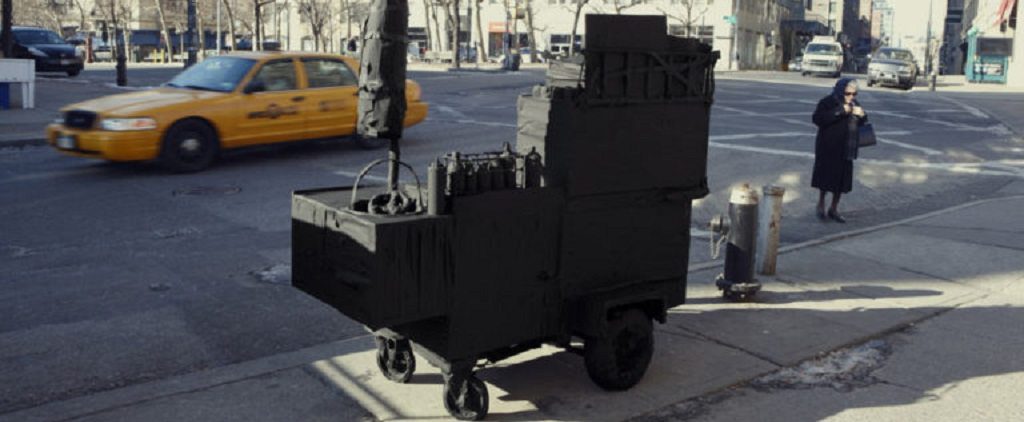[dropcap style=”font-size:100px; color:#992211;”]I[/dropcap]n anticipation of the Krisis exhibition and events programme opening at Nottingham’s Bonington Gallery tomorrow, exhibition curators Something Human talk to John Clang and Sama Alshaibi about the photographic work they will be exhibiting.
How do you work with the photographic image as a medium? What is your creative process?
John Clang: It is interesting that you ask about the photographic image, rather than photography as a medium. Photography, to me, is a recording and an archiving process of materials to form my thoughts. What I do next with the materials is my reaction/response to my thoughts. So, in principle, I always work on images created by me, not found images.
John Clang, Street Vendor, Silhouette/Urban Intervention (Black Tape), 2009
Sama Alshaibi: If I’m being honest, I don’t consider the medium first. I am more concerned with what I want to question and then I consider the possibilities of outcomes derived by various mediums. However, I’m quite comfortable with most cameras and the photographic image, or even the moving image (such as video) to aid me in asking such questions. The ideas I’m concerned with are already articulated in a puzzle in their final, visual expression. I’m not providing easy to read photographs to my audiences.
Photographs, as a mean of delivery, are second nature to me. I have been making them since I was a child. Using the camera, instead of sculpture for example, eliminates irrelevant uncertainties and allows me to concern myself with the pressing issues that motivated me to make the work in the first place. I know how the language of photography operates, but that can be a trap in itself.
I often ask myself, how do I remain sincere and authentic to what and who I’m hoping to be in dialogue with through a medium that is second nature to me? It isn’t an easy answer.
In your works, you depict certain conditions of the world around us. What is your motivation for doing so? What do you think art can achieve?
John Clang: I’m interested in creating a body of works that inform future historians or viewers of the mindset, the thinking process of another human being living in this specific period of time – somewhat similar to those cave drawings that were being done 30-40,000 years ago.
We have no lack of images nowadays so my focus has always been about the recording of our inner mind rather than our physical world. Art can help us understand and tolerate one another a bit more.
Sama Alshaibi: My motivations are simple regardless of the complexities in achieving it through art. I’m driven to fight for justice, but I’m not naïve enough to believe I can achieve that alone, by any means of struggle, let alone just through my art. But I do believe that artists, through their choices in art making, can strive for a “just” contribution – to bring balance, even within the horrors of the human and social conditions that are part of being alive.
Whether through representation, contextualised through a visual argument of why that representation is lacking, or asking the early and meaningful questions society is not ready to address, art always contains the potential to surpass the status quo. It can do more than depict and inform. It can also inspire. It can tap into spaces and possibilities not apparent in the moment of suffering. While many live in conditions in which inequality has devastating effects, enduring dissimilar causes that result in various types of suffering, in the end, it is still suffering.
My art practice, at its best, is not about me, even if I’m the one that makes the decisions of what to produce. I haven’t produced the conditions we live in, but through my art, I can imagine other conditions and ask my audience to consider that too.
 Sama Alshaibi, Ma Lam Tabki (Unless weeping), 2014, Courtesy of the artist and Ayyam Gallery
Sama Alshaibi, Ma Lam Tabki (Unless weeping), 2014, Courtesy of the artist and Ayyam Gallery
Atmospheric backdrops/landscapes and anonymous humans are referenced in your works presented in the Krísis exhibition. How do you relate to the notion of ‘crisis’ in your practice? How do you think your works address this human and environmental condition?
John Clang: There are many angles from which to look at crisis. My focus is on ‘internal crisis’ resulting from the changes in our bigger environment, over which we have little control. I am not interested in creating work just depicting the issues or crises in the world. I’m interested in negotiating the nuances in our response to these crises or shifts.
Sama Alshaibi: The “faceless” body is a strategy I use in my work to implicate all of our positions and bodies – the universal us – in a dialogue of crisis. Not just me, the artist, but all of us, as stewards of the planet in our current reality and what the future provides/condemns for those who will come after our own moment on earth.
‘Crisis’ could be perceived as a threatening term, but I hope it has the effect of demanding a confrontation with what we must deal with now. Especially the environmental catastrophe that undoubtedly shapes the conditions that humans will face politically and economically, resulting in the social and bodily impact. I ask myself, is it enough to just be aware of a crisis, or represent it through my work? My photographs in this exhibition are relics of testing my own body and its vulnerabilities in communities and physical spaces struggling in crisis.
However, I can’t ever represent it in a manner that truly speaks to such difficult circumstances, no matter my favourable intentions. I aspire to communicate effectively with a sensitive audience willing to engage in empathy. The complexities and specificity of any topic addressed in my work is only compelling (by my own standards) if the audience realise it is just as much about them, albeit in a different context. Our environmental circumstances are interrelated, as are our personal ones, and all suffering is in the end, the same.

















